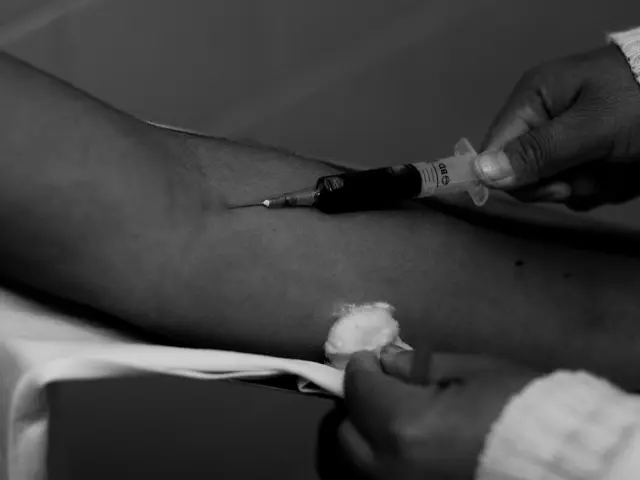Thin Blood: Causes, Signs, and Care
In our bodies, a balanced and healthy blood composition is essential for proper functioning. One of the four main components of blood is platelets, small cells that play a crucial role in blood clotting. However, when the number of platelets drops below the normal range, a condition known as thrombocytopenia, or "thin blood," can occur.
Thrombocytopenia may present with various symptoms, such as slow wound clotting, bleeding gums, nosebleeds, blood in the stool, heavy menstrual flow without clots, purpura (sudden bruising), and petechiae (pinprick hemorrhages on the skin). It is essential to consult a doctor if these symptoms are experienced, as thrombocytopenia can lead to problems with clotting, wound healing, and bruising.
Several factors can contribute to the development of thrombocytopenia. One common cause is immune thrombocytopenia (ITP), an immune system disorder where the body's immune response mistakenly destroys platelets. Another cause, gestational thrombocytopenia, occurs during pregnancy due to increased plasma volume diluting the platelet concentration.
Medications, nutritional deficiencies, autoimmune conditions, other medical conditions, and alcohol use disorder can also lead to thrombocytopenia. For instance, certain drugs, including some used during pregnancy and chemotherapy agents, can reduce platelet production or increase destruction, causing thrombocytopenia. Severe folic acid deficiency can lead to decreased platelet production, especially noted in pregnancy.
In addition to immune thrombocytopenia and gestational thrombocytopenia, other autoimmune diseases, hemolytic anemia, diabetes, heart disease, myeloproliferative diseases, and excessive alcohol consumption can result in platelet destruction or reduced production, contributing to thrombocytopenia.
Anticoagulant medications, such as heparin and warfarin, are prescribed when blood is thick and a person has an increased risk of blood clots, stroke, or heart attack. Treatment for thrombocytopenia may involve corticosteroids in conditions like idiopathic thrombocytopenic purpura (ITP), and in severe cases, platelet transfusions.
It is crucial to maintain adequate hydration levels to keep blood at an optimum thickness, as dehydration can cause blood to thicken and blood vessels to constrict. Low platelet counts affect about 10% of pregnant people at the time of birth, and a doctor diagnoses thrombocytopenia by conducting a complete blood count (CBC).
In conclusion, thrombocytopenia is a condition characterised by a low number of platelets in the blood, which can lead to problems with clotting, wound healing, and bruising. Understanding the causes, symptoms, and treatment options for thrombocytopenia is essential for early diagnosis and effective management of the condition. If you experience any symptoms suggesting thin blood, consult a healthcare professional immediately.
- In addition to causing clotting problems, thrombocytopenia may manifest as slow wound clotting, bleeding gums, nosebleeds, blood in the stool, heavy menstrual flow without clots, purpura, and petechiae.
- Thrombocytopenia can be caused by several factors, including immune thrombocytopenia, where the body's immune response mistakenly destroys platelets, and gestational thrombocytopenia, which occurs during pregnancy due to increased plasma volume diluting the platelet concentration.
- Other causes of thrombocytopenia include medications, nutritional deficiencies, autoimmune conditions, various medical conditions, and alcohol use disorder.
- For instance, certain drugs like those used during pregnancy and chemotherapy agents can reduce platelet production or increase destruction, leading to thrombocytopenia.
- Severe folic acid deficiency can also lead to decreased platelet production, especially noted in pregnancy.
- Among other autoimmune diseases, hemolytic anemia, diabetes, heart disease, myeloproliferative diseases, and excessive alcohol consumption can result in platelet destruction or reduced production, contributing to thrombocytopenia.
- Anticoagulant medications, such as heparin and warfarin, are prescribed when blood is thick and a person has an increased risk of blood clots, stroke, or heart attack.
- Treatment for thrombocytopenia may involve corticosteroids in conditions like idiopathic thrombocytopenic purpura, and in severe cases, platelet transfusions.
- It is essential to maintain adequate hydration levels to keep blood at an optimum thickness, as dehydration can cause blood to thicken and blood vessels to constrict.
- Low platelet counts affect about 10% of pregnant people at the time of birth, and a doctor diagnoses thrombocytopenia by conducting a complete blood count (CBC).
- A balanced and healthy blood composition is essential for proper functioning, and managing chronic diseases like thrombocytopenia, diabetes, mental health disorders, multiple sclerosis, breast cancer, NSCLC, Crohn's disease, and obesity contributes to overall health and wellness.
- Fitness and exercise, along with proper nutrition, play a crucial role in preventing and managing various health and wellness issues, including chronic diseases, mental health disorders, and blood-related conditions like thrombocytopenia.








